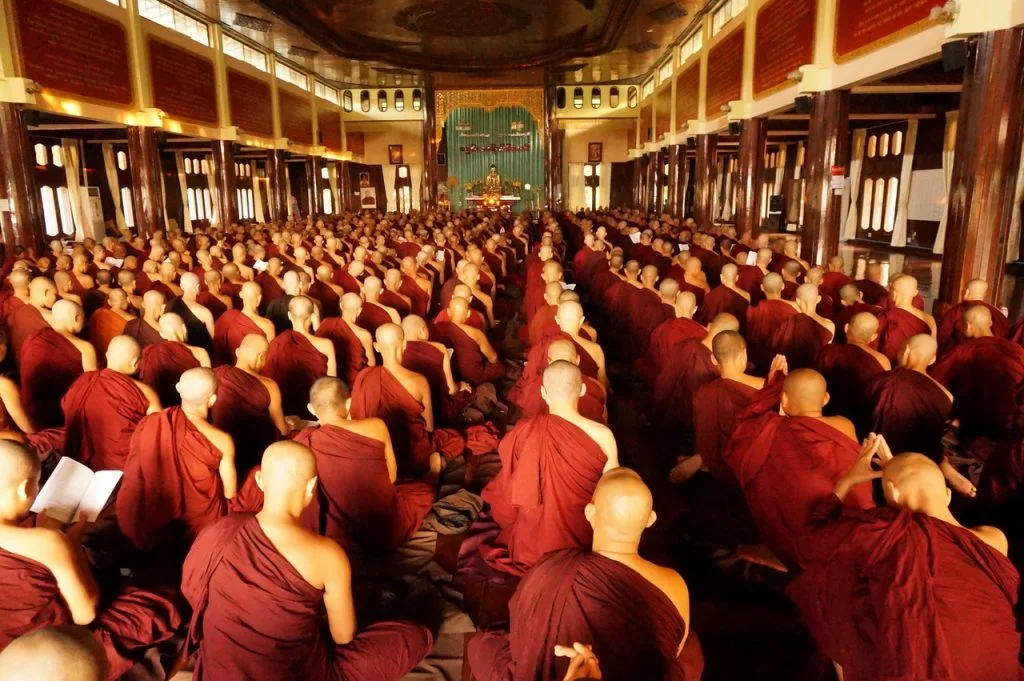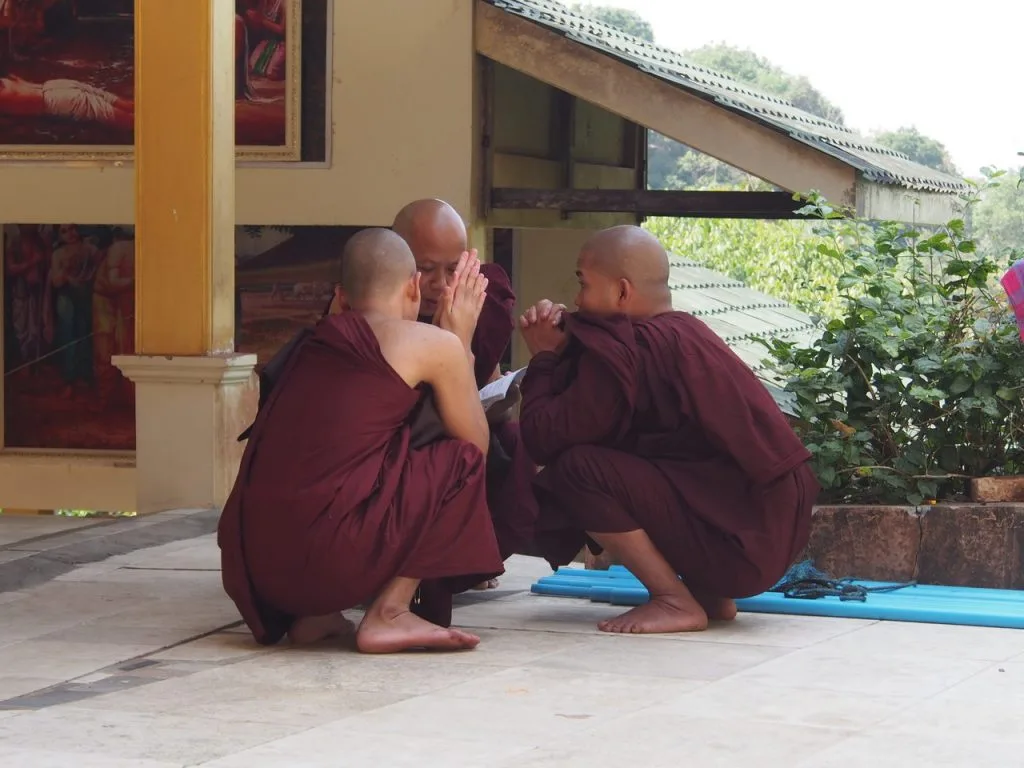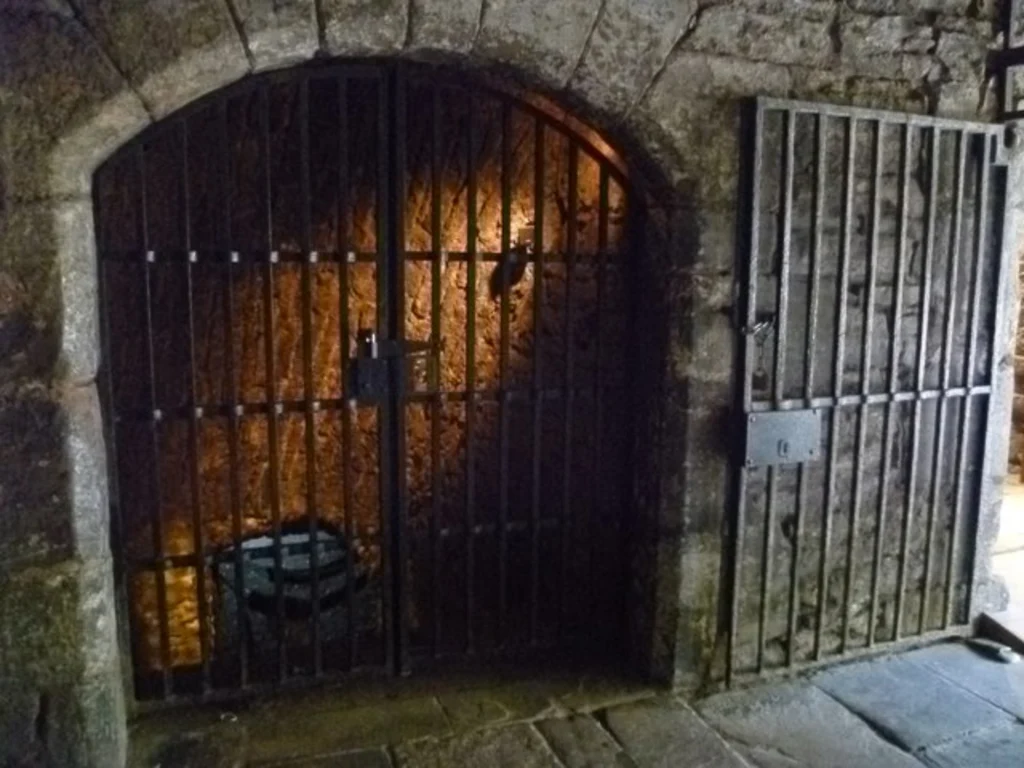What Is The Bhikkhu Patimokkha or Buddhist Monk Rules?

Pa Auk Monastery in 2014, Photo by Klaus
The Pātimokkha is a set of 227 rules for the bhikkhus belonging to the Theravāda sect which is based on the Pāḷi language texts. The 227 rules are grouped into seven classes with the first two, Pārājikā and Saṅghādisesā considered as “heavy”. The first heavy group is also considered irrecoverable while the second requires official transactions to restore the full bhikkhu status to the offender. The seven classes are listed below:
The Seven Classes of Rules
Pārājikā: 4 Rules that cause a defeat. If the monk commits any of these rules he is automatically disrobed, without a trial. Even if he continues to wear robes without telling the others of his offense, he is still not a monk.
Saṅghādisesā: 13 Rules requiring a meeting of the community. If a monk breaks any of these rules, he loses his full status of being a monk for 6 nights plus extra nights that he concealed his offense. He must announce his offense to the community each day.
Nissaggiya-pācittiyā: 30 Rules which require forfeiture of items, often improperly obtained (like using money or objects bought with monk-owned-money). These offenses are not cured until the items are relinquished.
Suddha-pācittiyā: 92 Rules which require confessions.
Pāṭidesanīyā: 4 Indeterminate rules.
Sekhiyā: 75 Training rules.
Adhikaraṇasamathā: 7 ways to settle disputes.
Pārājikā
The first group of rules, called Pārājikā, consists of 4 rules:
- sex
- stealing (usually worth more than 1/24 troy ounce of gold)
- killing a human or speaking praise of death resulting in death such as praising abortion or euthanasia
- lying about superhuman attainments such as jhāna, psychic powers, or enlightenment
If a monk commits any of these four rules to the slightest degree, he is automatically no longer a monk at that very moment even if he continues to wear the robes.1
Saṅghādisesā
There are 13 Saṅghādisesā rules. The ones that usually come up in actual monk life are: intentional emission of “life fluids”, touching women, and speaking to women with lewd words directly or indirectly with a lustful state of mind. Monks also cannot perform marriage ceremonies or act as a “go-between” to “match up” men and women.
If a monk breaks any of the 13 rules, he must undergo a rehabilitation process where he loses his full status as a monk and collects his food last and is seated last. In addition, and the most difficult part, he must also inform all monks in the monastery of his offense(s) each day during this period.
There is also a probation period which extends the length of time for the number of days the offense was concealed. There must be at least 20 monks to participate in restoring his full status.2
Nissaggiya-pācittiyā
The Nissaggiya-pācittiyā rules are 30 in number. They mostly consist of keeping extra robes or bowls beyond 10 days, not being within an arm’s reach of the 3 robes at dawn, not asking for robes within proper conditions, and keeping medicinal tonics for more than 7 days.
In addition to that, one is not allowed to use money or items bought with monk-owned money.
All of these items are considered Nissaggiya and must be forfeited. As long as the monk has not fully relinquished or still has mental possession of these items, he will not be pure. If this persists as a daily practice, the monk’s life is counterproductive toward self-salvation and it is said he will be born in the lower realms for this if practiced until death.3
Unfortunately, more than 95% of all monks engage in breaking this class of rules, usually by accepting and handling money. A video explains this below:
Short video of why using money is bad.
The reciter of the Pātimokkha will ask the assembly of monks if they are pure after each section is finished. Even if the monk is “silent” when asked, this is counted as lying if he is not pure. Since most monks use money, most monasteries rarely recite the Pātimokkha. If they do, it is only during the Rainy Season—and they often stop reciting just before the section on Nissaggiya.
In this way, by chanting only 25% of the Pātimokkha, they avoid being asked if they are pure regarding money and items bought with monk-owned money and can avoid “lying by remaining silent.”
Uddiṭṭhā kho āyasmanto tiṃsa nissaggiyā pācittiyā dhammā… Parisuddhetthāyasmanto, tasmā tuṇhī, evametaṃ dhārayāmīti.
The thirty rules of forfeiture have been recited, sirs. Herein I ask the venerable ones: Are you pure in this? … The venerable ones are pure herein; that is why they are silent. So do I record it.
The Other Rules
The rest of the rules are too numerous to mention. However, some are worth noting, such as:
- Not being able to sleep in the same lodging as women
- Not to damage living plants
- Not to eat after Solar Noon
- Not to eat stored food
- Not to eat unoffered food
- Not to ask for anything without being invited
- Not to drink alcohol
- Not to ordain one who is younger than 20 years old
The Sekhiya day-to-day behavior rules are classed into several groups:
- How to wear the robes and conduct while in the village
- Rules on collecting food
- Rules for eating food
- Rules regarding teaching the Dhamma
- Rules for spitting and “toilet duties”
Accumulation of Rules
Ko pana, bhante, hetu, ko paccayo yena etarahi bahutarāni ceva sikkhāpadāni honti appatarā ca bhikkhū aññāya saṇṭhahantī”ti?
“And what is the cause, what is the reason why these days there are more training rules and fewer enlightened mendicants?”“Evametaṃ, bhaddāli… saddhamme antaradhāyamāne… appatarā ca bhikkhū aññāya saṇṭhahantīti.”
“That’s how it is, Bhaddāli. When sentient beings are in decline and the true teaching is disappearing, there are more training rules and fewer enlightened mendicants.”Bhaddāli Sutta MN 65
The rules were made one by one, as needed, as time went on. The Buddha’s early students automatically followed proper vinaya and knew what monks should do.
After about 20 years, monks with less past-life pāramī ordained and started breaking the unwritten code of conduct. The first rules to come were the Pārājikā rules. Later the other rules were formulated to make 227 rules plus smaller khandhaka rules found in the Mahāvagga and Cūḷavagga vinaya texts.
There is mention in three suttas about “having more than 150 rules” for the Pātimokkha. Some rogue monks believe that the Pātimokkha should therefore only have 150 rules. However, just as the suttas were made over a long period of time, so too was the accumulation of the rules.
Furthermore, the phrase sādhikam diyaddhasikkhāpadasatam is defined as:
- sādhikam = more than, in excess of
- diyaddhasikkhāpadasatam = the number 150
It might also be an idiom. There are other numerical idioms in the texts. However, as cultural norms have passed, it is difficult to know for sure. The rogue monk who performed a 150-rule Pātimokkha with his followers was eventually expelled from the Ajahn Chah tradition.
Na me, bhikkhave, tesu bhikkhūsu anusāsanī karaṇīyā ahosi;
“I didn’t have to keep on instructing those mendicants.”satuppādakaraṇīyameva me, bhikkhave, tesu bhikkhūsu ahosi.
“I just had to prompt their mindfulness.”Kakacūpama Sutta — The Simile of the Saw
Recitation
The Pātimokkha is recited on the new and full moon days, called the Uposatha days of the 14th or 15th lunar cycles.
All monks are required to come to the Uposatha hall (sīma). The monks must purify their offenses before entering by confessing and relinquishing unallowable items, usually from the Nissaggiya-pācittiyā section.
Those who still hold money or items bought with monk-owned money and cannot bear to relinquish them completely are not allowed to attend. These monks will not be pure no matter how many times they confess.

New and Full moon days are Uposatha Days.
Confession
Confessor: Ahaṃ bhante, sabba āpattiyo āvikaromī — “Venerable Sir, I disclose all of my offenses in the open.”
Acknowledger: Sādhu! Sādhu! Sādhu!
Confessor: Ahaṃ bhante sambahulā nānā-vatthukāyo āpattiyo āpanno. Tā paṭidesemi.
“Venerable Sir, I confess all of the various offenses to you.”
Acknowledger: Passasi āvuso? — “Do you see your offense?”
Confessor: Āma bhante, passāmi. — “Yes, I see.”
Acknowledger: Āyatim āvuso saṃvareyyāsi. — “Will you not do this in the future?”
Confessor: Sādhu suṭṭhu bhante saṃvarissāmi. (Three times.) — “Yes, I will not do this in the future.”
A monk who has money or items bought with monk-owned money on him, in his kuti, or held by a friend cannot honestly purify his offenses with these statements.
The confession requires him to agree to stop doing such actions and relinquish what needs to be relinquished. If he doesn’t, his purifying confession of light rules is not complete if the nissaggiya items still remain.

Confession, Pa Auk Monastery in 2014 Photo by Klaus.
Theoretically, everyone who enters the Pātimokkha before recitation is pure because they have properly confessed. Pa-Auk does not ask many questions to monks from other monasteries with money-handling history, but other monasteries will.
The Pātimokkha is recited in full here:
https://youtu.be/aDzyClD2S6g
Mahayana and Bhikkhuni Pātimokkha
Pātimokkha is a Pāḷi word and refers to Pāḷi Buddhism or Theravāda Buddhism.
Mahayana, which is based on Chinese or Sanskrit, is not discussed here. Those who were part of the first revival of the “bhikkhuni saṅgha” of this century who wear Theravāda bhikkhuni robes are actually rooted or mixed with the Chinese Mahayana sect.4
Nevertheless, a real Theravāda bhikkhuni has 311 rules to follow plus the 8 garu-dhamma rules. Many rules are the same, yet some differ.
Bhikkhunis have additional heavy rules and serious consequences. Lay people should pay careful attention to the following bhikkhuni rules with heavy consequences:
- They are not allowed to spend the rains retreat alone without bhikkhus nearby. (Garudhamma)
- During each Uposatha, the bhikkhunis must address the saṅgha of bhikkhus to inquire about two things: the date of the uposatha and the dhamma teaching. (Garudhamma)
- They are not allowed to travel alone without another bhikkhuni present. (Saṅghādisesā)
- They are not allowed to sleep alone without another bhikkhuni present. (Saṅghādisesā)
A real Theravāda bhikkhuni who breaks any of these above rules, found nearly verbatim in all textual versions of all vinaya sects, needs to lose her full status and follow rehabilitation as stated in the Saṅghādisesā section.
Instead of six nights, they need two weeks. Although the rehabilitation base time is longer, there is no bonus time for concealing. Afterwards, they need at least twenty bhikkhus and at least twenty nuns as quorum to restore their full status.5

Are Theravāda Bhikkhuni Ordinations Valid?
There is not much written in English explaining why bhikkhuni ordinations are rejected by the Theravāda Community of Monks.

Should Bhikkhunis Be Sent To Probation Monasteries?
Did you know that bhikkhunis (nuns) are not allowed to sleep or travel alone and if they do, they are sentenced to 2 weeks of rehabilitation?
Conclusion
The Pātimokkha is a central part of the bhikkhu monastic life. It defines the rules of how the monk should behave and live.
Can you imagine not using money or eating after Noon? That is why the rules play a central role and affect the monks on a daily level. There are rules on how to eat, dress, and even go to the toilet.
There are 227 Pātimokkha rules but also numerous smaller khandhaka rules, perhaps in the thousands. There are five Vinaya (rule) books in total.
While it sounds like such rules might drag one down, they are designed to help liberate one from the fetters that prevent enlightenment. That is why Pātimokkha is rooted in √mokkh (“to be freed”). It should always be seen as a way to freedom rather than as bondage.
May you join the community of monks (saṅgha) and follow the morality and Path to Freedom!
For this reason, because we don’t know who has fallen, bhikkhu ordination ceremonies are often better if there are seven or ten bhikkhus even though one only needs five. This helps protect the minimum quorum needed for ordinations. ↩︎
Usually it is preferred to have 25+ monks just in case to protect the twenty-bhikkhu quorum. ↩︎
“Sāpattikassa, bhikkhave, nirayaṃ vā vadāmi tiracchānayoniṃ vā”ti — “For one with offenses, monks, I declare either hell or the animal realm.” ↩︎
You can read full details here: Are Theravāda Bhikkhuni Ordinations Valid?. In order to be accepted, it must be recognized by the general Theravāda saṅgha with unanimous support. Theravāda Buddhism is democratic. ↩︎
As stated before, it would be preferred to have twenty-five from each group. ↩︎
Click below to search subjects